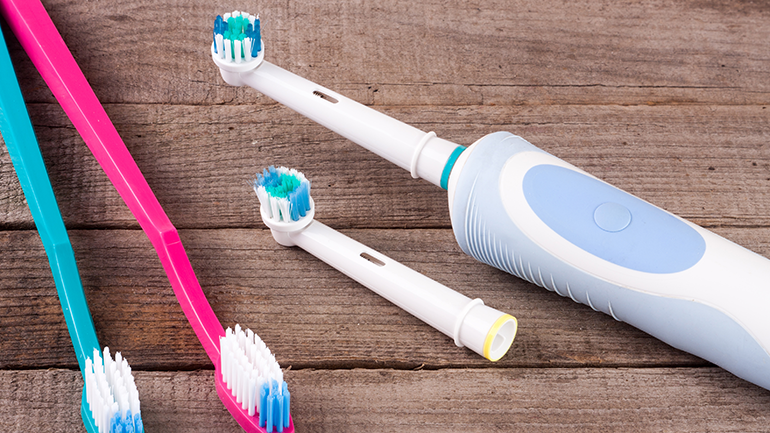
Choosing how to best do that sometimes isn’t as simple: which is better at cleaning, the manual or electric toothbrush?
The purpose of a toothbrush is simple: to clean teeth and gums by removing plaque. But choosing how to best do that sometimes isn’t as simple: which is better at cleaning, the manual or electric toothbrush? The answer comes down to technique, frequency of brushing, length of brushing time, and individual needs and preferences.
Both manual and electric toothbrushes are capable of keeping your teeth plaque- free but their effectiveness is dependent on technique of brushing. Proper positioning of both brushes – did you know you should angle bristles at 45 degrees? – is important in creating the most effective removal of plaque, both above and below the gum line.
The electric toothbrush may be helpful if you have difficulty with brushing methods, all you need to do is position the toothbrush head according to the manufacturers’ or your dental professional instructions, and it does all the work for you. Studies have shown that brushing two-three times a day for two minutes is ideal. So no matter which brush you use, remember the 2x2 rule.
Brushing Pros and Cons
|
Manual |
Electric |
|
Inexpensive |
More costly |
|
Portable |
Portable/Needs charging |
|
Easy to use |
Easy to use |
|
Brushing action required |
Brushing action automatic |
|
Need to keep track of time |
Timers usually built-in |
|
Need gentle pressure |
Pressure sensors built-in |
Other things to consider are mobility and strength – children and the elderly may be incapable of holding narrow toothbrush handles, lack control maneuvering a manual toothbrush for proper brushing, or have fixed appliances in the mouth like braces which need extra attention. These needs may sway you toward an electric toothbrush. Discomfort with the feeling of vibration in your mouth, not having an outlet in your washroom, or the added cost may sway you towards a manual toothbrush.
Remember: the best kind of toothbrush is the one you use regularly. It all comes down to how many times you brush a day, how long you brush, and your brushing technique. Consult your dental professional to find out the technique that is best for you and your pearly whites.
Did you know?
- Brushing forcefully or using a hard bristled manual or electric toothbrush will damage your teeth and gums, which may cause sensitivity.
- Soft bristles are the best choice for your gums and teeth whether you are using a manual or electric toothbrush.
- Both manual and electric toothbrush heads should be replaced every three months, when bristles are no longer straight and firm, or after a cold or flu.
- For complete oral care, it’s also important to gently brush your tongue or use a tongue cleaner.
- Along with brushing, flossing and using an antibacterial mouthwash also improves oral health.
Source: The B.C. Dental Association’s publication Your Dental Health.
